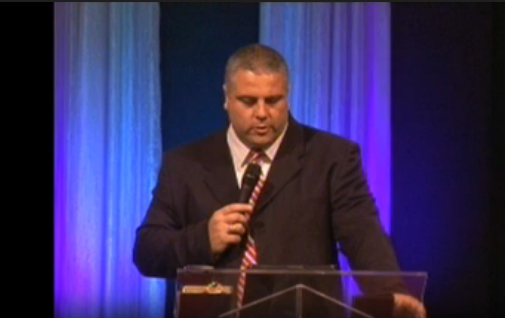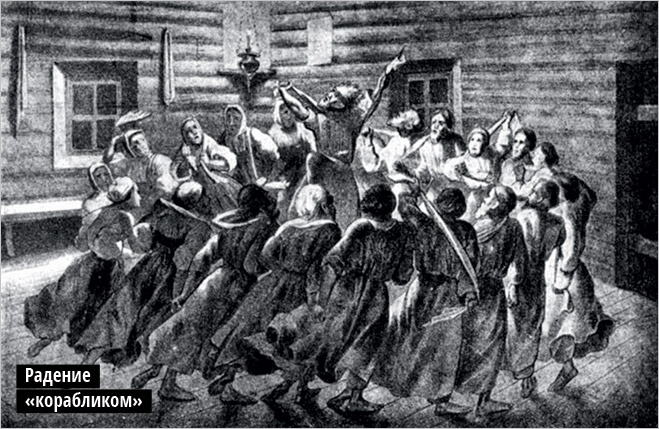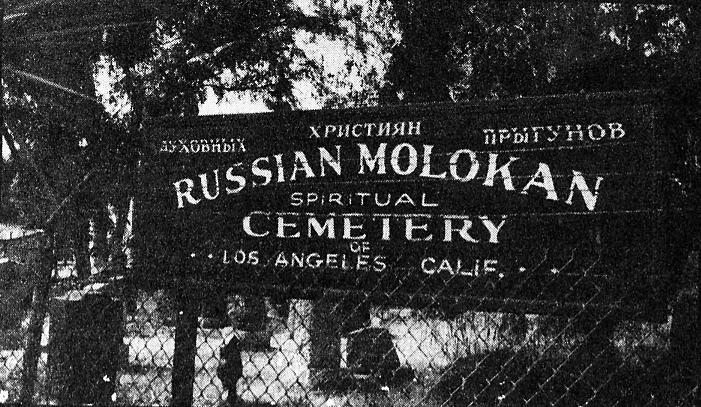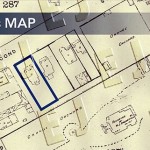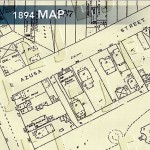Were Molokans the first to Speak in Tongues at Azusa?
Adopted from Andrei Conovaloff
American Molokan Dukh-i-zhiznik (lit. living in the Spirit) oral history (documented in the Book of the Sun: Spirit and Life, Dukh i zhizn’) reports that Molokani and Pryguny received the “outpouring of the Holy Spirit” in the Milky Waters region (now in Ukraine) in 1833. The diary of Vassili V. Verestchagin documents that Pryguny (lit. leapers) in the Caucasus in the early 1860s spoke in tongues, jumped to exhaustion, and held hands up in the air for more than an hour. These charismatic practices continue among Dukh-i-zhizniki in the U.S. and Australia.
From 1906 to 1909, the Apostolic Faith Mission conducted three services a day, seven days a week, for over three years or 1000+ services! Thousands of seekers received the “tongues” baptism, including many Molokani and Pryguny. Also many public Pentecostal revivals were conducted in tent meetings on Oake’s lot and other locations around the Flats area slums were Russian settled. English speaking Pryguny and other Russians immigrants often translated at the services. Oake’s lot later became Pecan Playground, at First and Pecan Streets.
In Molokans in America (pages 101-102, ch. 5), John K. Berokoff reports about the connection between Prygun leader Philip Mikhailovich Shubin and the early Pentecosts:
“During his 27 years in America he was the outstanding speaker and orator of the brotherhood with a wide acquaintance among non-Molokans , not infrequently taking a choir of singers to Pentecostal church meetings where he preached and explained the Molokan reasons for their migration. It was his wisdom, his profound knowledge of the scriptures plus his wide knowledge of Russian literature that enabled him to repel the periodic attempts by leaders of neighboring denominations—Baptists, Pentecostals, etc.—to proselytize the Molokan people …”
More evidence of connections between the Azusa Street Revival and the Pryguny is reported in the newspaper The Apostolic Faith, which was distribute free to 50,000 subscribers, when the population of Los Angeles was 250,000. Many Russian sectarians in Flats knew about this church and saw this free paper, especially since it reported about them in the first issue, the church was within walking distance, and elders exchanged visits.
1906 September — The Apostolic Faith (Volume 1 Number 1) — The first edition of the newspaper reports that Apostolic Faith Mission members spoke at a Prygun prayer meeting. In 1906, Pryguny held Sunday services at the Bethlehem Institutional Church and the Stimson-Lafayette Industrial School, and welcomed guests at both locations which were 1/2 block from each other and about 1/4 mile east of the Apostolic Faith Mission. The Pentecosts invited the Pryguny to attend their meetings, which many did with a translator:
RUSSIANS HEAR IN THEIR OWN TONGUE
“Different nationalities are now hearing the Gospel in their own “tongue wherein they were born.” Sister Anna Hall spoke to the Russians in their church in Los Angeles, in their own language as the Spirit gave utterance. They were so glad to hear the truth that they wept and even kissed her hands [showing respect]. They are a very simple, pure, and hungry people for the full Gospel. The other night, as a company of Russians were present in the meeting, Bro. Lee, a converted Catholic, was permitted to speak [translate] their [Russian] language. As he spoke and sang, one of the Russians came up and embraced him. It was a holy sight, and the Spirit fell upon the Russians, as well as on others, and they glorified God.”
1907 April — The Apostolic Faith (Volume 1 Number 7) — The 7th edition reports about the Russian and Armenian Pryguny in the Flats:
“Russians and Armenians in Los Angeles are seeking the baptism. The Armenians have a Pentecostal cottage meeting on Victor street, between 4th and 5th [Now under the I-5 Freeway]. Some have been baptized with the Holy Ghost.”
In his 2006 book, The Azusa Street Mission and Revival: The Birth of the Global Pentecostal Movement, Cecil Robeck reports that in 1906 Los Angeles had a population of 238,000 and was growing at the rate of 3,000 (1.3%) per month, as ~ 4,000 Russian sectarians migrated to the U.S. He mentions the Russian and Armenian Pryguny at least 5 times in his book:
[Page 57] Finally, between 1903 and 1912 several thousand Russians and Armenians arrived in the city, refugees from Russia’s increasingly repressive government. Unlike most Russians, they did not belong to the Orthodox church. They were [Spiritual Christian ethnic] Molokans, literally “milk drinkers,” a name they received because they refused to fast from dairy products during traditional fast days. More importantly, they could be described as a “proto-Protestant'” group, since they had been influenced by some of the sixteenth-century Reformers. They also had a special appreciation for the Holy Spirit. Many of them claimed that they had been directed to leave southern Russia through the gift of prophecy. They engaged in what was often described as ecstatic behavior, jumping and dancing; falling on the floor when they believed that they were possessed of the Holy Spirit to do so; and singing chant-like songs that strongly paralleled the “singing in the Spirit” (a multi-layered, harmony-rich singing in tongues that are unknown to the singers and are believed to be inspired by the Holy Spirit) at the Azusa Street Mission.
[Page 94] As the revival grew … Seymour celebrated the spread of the revival to other congregations … the Russian Molikan [sic] community, … He viewed them as fellow-workers.
[Page 138] While the mission was led by an African American pastor, dominated by and African American membership, and heavily influenced by African American worship patterns, it quickly developed into a multi-ethnic and multiracial congregation. … non-African-Americans did bring their own gifts and experiences. … Recent Russian and Armenian Molokan [Spiritual Christian] immigrants already practiced the unusual jumping and chanting also found at the mission. … This was a revival unlike any other the city of Los Angeles had ever seen … African Americans, Latinos, Armenians, Russians, Swedes, Germans, Italians, Chinese, Japanese, Native Americans, and other ethnic groups … bountiful expressions of ecstatic manifestation such as speaking in tongues, prophesying, claims of dreams and visions, trances, healings, exorcism, and falling “in the Spirit.”
[Page 153] “Singing in the Spirit” accomplished more than an expression of worship, however. It also provided a bridge that brought Russian and Armenian Molokans [Spiritual Christian Jumpers] into the mission — among them the Shakarian and Mushegian families. These families arrived in Los Angeles in the 1905 emigration. The Molokans commonly practiced a king of “sing-song” prayer, a form of vocal prayer and praise that resembled singing in Spirit.” Walking down San Pedro Street in 1905, Demos Shakarian, grandfather of the Demos Shakarian who would later found the Full Gospel Businessman’s Association, and his brother-in-law, Magardich Muchegian, passed the Azusa Street Mission. As they drew near, they heard sounds of praying, singing, and speaking in tongues coming from the mission — expressions that they identified as similar to their own. The single phenomenon of “singing in tongues” convinced Demos to embrace the mission as a place his family could worship. From the moment he heard it, he concluded that God was also beginning to move to America just as He had in their homeland of America and in Russia.”(27)
[Pages 189-190] At the same time a group of Armenians and Russians [Spiritual Christian Pryguny], who had come to Los Angeles in the Molokans immigration, opened cottage prayer meetings on Victoria Street between West Fourth and Fifth Streets that would quickly develop into an Armenians-language Pentecostal church.
American-born Armenian-Prygun historian Joyce Bivin comments: We have a similar story in our community about the Azusa Street Revival. The story goes like this — quoted from a letter by M. Mushagian:
“Our people came to Los Angeles right after the Azusa Street Revival. They used to attend the meetings even though they didn’t understand the American language. They saw that the Holy Spirit was moving there like it did in the Old Country. So they accepted Pentecostal because they believed in Acts 2:4.”
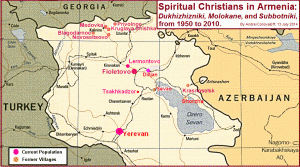 The Armenians apparently were worshiping in this manner, including dancing in the Spirit, (jumping, which my grandmother did at one of the Paskha meetings and the next day mother told me she was healed of whatever affliction she had at the time), prophesying, speaking in tongues, etc. before they came to America. I wasn’t aware the Molokans responded to the Azusa Street meetings. After the Armenians visited the Azusa Street meetings, they eventually changed their identity from Armenian Molokans to Armenian Pentecostals. Though they kept the Molokan traditions in their worship, their theology shifted from focusing on Jesus and M.G. Rudometkin (whose book was next to the Bible on the table) to Jesus’s teachings as defined by Pentecostal/Protestant doctrine.
The Armenians apparently were worshiping in this manner, including dancing in the Spirit, (jumping, which my grandmother did at one of the Paskha meetings and the next day mother told me she was healed of whatever affliction she had at the time), prophesying, speaking in tongues, etc. before they came to America. I wasn’t aware the Molokans responded to the Azusa Street meetings. After the Armenians visited the Azusa Street meetings, they eventually changed their identity from Armenian Molokans to Armenian Pentecostals. Though they kept the Molokan traditions in their worship, their theology shifted from focusing on Jesus and M.G. Rudometkin (whose book was next to the Bible on the table) to Jesus’s teachings as defined by Pentecostal/Protestant doctrine.
The first place our people gathered to worship was on Boston Street. The next place was on 431 S. Pecan Terrace, in a large room where my great grandfather eventually turned into a bath house. Then they moved to Gless Street [all in the Flats] and next to Goodrich Blvd before moving to Hacienda Heights. The church today is located in Hacienda Heights, off Hacienda Blvd. on West. It’s the first entrance on the right after you turn on West.
School Youth Revival Takes Over Delbarton, West Virginia
Exactly 9 months after ministering at the Regional Church of God in Delbarton, WV
Frank Bartleman: The EARTHQUAKE
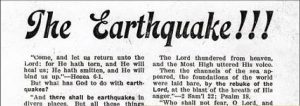 “Come, and let us return unto the Lord: for He hath torn, and He will heal us; He hath smitten, and He will bind us up.” – Hosea 6:1.
“Come, and let us return unto the Lord: for He hath torn, and He will heal us; He hath smitten, and He will bind us up.” – Hosea 6:1.
But what has God to do with earthquakes? “And there shall be earthquakes in divers places. But all these things are but the beginning of sorrows.” – Matt. 24:7-8. Judgment for sin.
“Arise, go to -, that great city, and cry out against it; for their wickedness is come up before Me.” – Jonah 1:2.
Her sins have reached unto heaven, and God hath remembered her iniquities.” – Rev. 18:5.
“When Thy judgments are in the earth, the inhabitants of the world learn righteousness.” Isa. 26:9.
“God is angry with the wicked every day.” – Psalm 7:11.
For it is God that “removeth the mountains and overturneth them in His anger; that shaketh the Earth out of her place, and the pillars thereof tremble.” – Job 9:5-6.
Therefore, “stand in awe, and sin not.” (Psalm 4:4), lest He return, and “wring out a full cup.” – Psalm 73:10.
“The mountains quake at Him, and the Earth is upheaved at His presence.
“His fury is poured out like fire, and the rocks are broken asunder by Him.” – Nahum 1:5-6.
“I will punish the world for their evil, and the wicked for their iniquity.”
“The Earth shall be shaken out of her place, in the day of His fierce anger.” – Isa. 13:11-13.
And how else shall wicked men be kept in subjection? and wickedness be stayed?
God must needs make a fearful example at times. And who dares say that such is not deserved? God dare not wink at sin.
“The fear of the Lord is the beginning of wisdom.” – Prov. 9:10.
“THE EARTH SHOOK and trembled; the foundations also of the mountains moved and were shaken, BECAUSE HE WAS WROTH.
“There went up a smoke in His wrath, and FIRE OUT OF HIS MOUTH DEVOURED.
“The Lord thundered from heaven, and the Most High uttered His voice.
“Then the channels of the sea appeared, the foundations of the world were laid bare, BY THE REBUKE OF THE LORD, at the blast of the breath of His anger.” – 2 Sam’l 22; Psalm 18.
“Who shall not fear, O Lord, and glorify Thy name? for Thy righteous acts have been made manifest” – Rev. 15:4.
“Behold, the Lord maketh the earth empty, and turneth it upside down (perverteth the face thereof), and SCATTERETH ABROAD THE INHABITANTS THEREOF.
The foundations of the earth do shake, the earth is utterly broken, the earth is moved exceedingly.
“The earth shall stagger like a drunken man, and shall be moved to and fro.
“THE TRANSGRESSION THEREOF SHALL BE HEAVY UPON IT.” Isa.24:1, 18, 20.
“Fear ye not Me! saith the Lord: will ye not tremble at My presence!” – Jer. 5:22.
Shall I not visit for these things! saith the Lord: and shall not my soul be avenged on SUCH A NATION AS THIS?” – Jer. 5:9.
“THOU SHALT BE VISITED OF THE LORD OF HOSTS WITH EARTHQUAKE, and great noise, and the flame of A DEVOURING FIRE.” – Isa. 29:6.
“Come and see the works of God; He is terrible in His doing toward the children of men.
“Let not THE REBELLIOUS exalt themselves. – Psalm 66:5-7.
“Now consider this, YE THAT FORGET GOD, lest I tear you in pieces, and there be none to deliver.” – Psalm 50:22.
“Hell hath enlarged her desire, and opened her mouth without measure; and THEIR GLORY, and THEIR MULTITUDE, and THEIR POMP descend into it.” – Isa. 5:14.
Even the demons “believe, and tremble.” – Jas. 2:19.
It is not a question of bravery, but one of wisdom.
The man is A FOOL who does not fear to grieve God.
It is utter SUICIDE for one to take his life in his hands in such a case.
God has arisen “to SHAKE TERRIBLY the earth.” – (Isa.2:19) – to shake the sin out of it.
“I (God) will shake all nations.” – Haggai 2:7.
“Yet once more will I make to tremble not the earth only, but also the heaven.” (SPIRITUAL UPHEAVAL, WORLD-WIDE REVIVAL.) – Heb. 12:26.
“And THE SEVENTH ANGEL (of wrath) poured out his vial into the air and there was A GREAT EARTHQUAKE.” – Rev. 16:17, 18.
The recent earthquake has literally shaken this nation FROM SAN FRANCISCO TO BALTIMORE. The news of it has shaken the world.
WHAT NEXT?
Los Angeles received a slight shock later (a waning), at least for evil doers.
Rev. Lee Spangler, the prophet of Pennsylvania, declared some months ago that the following events would speedily transpire:
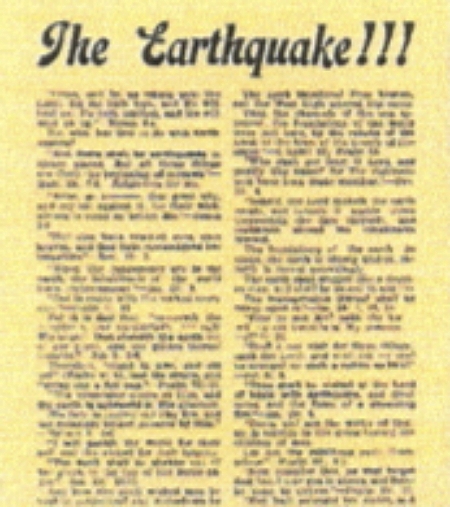 “A destructive eruption of Mt. Vesuvius.
“A destructive eruption of Mt. Vesuvius.
DESTRUCTIVE EARTHQUAKES IN CALIFORNIA. THAT CHRIST WILL MAKE HIS SPIRIT FELT AMONG THE PEOPLE OF THE UNITED STATES, IN WHICH COUNTRY THERE WILL BE A FERVENT RELIGIOUS MOVEMENT.”
It would seem as though these drastic earthquake measures were necessary in order to accomplish this in the hearts of the people.
Will we appreciate the waning, and God’s wonderful and unprecedented mercy in sparing life, in the recent shock? Also His mercy in sparing the Sister City (Oakland), for a refuge, and so wonderfully moving upon the hearts of the people to alleviate the sufferings of the stricken.
The reaction will be beneficial to our own hearts, in creating sympathy and love.
Our present and imperative duty is to pour, without stint, the oil of divine love and sympathy into the wound so recently made by the Almighty, that it may be healed, to the glory of God, and to the salvation of the souls of the people whose lives have been so miraculously preserved.
And let us “be not high minded, but fear” lest He spare not us. – (Rom II:20.)
Oh, people, tempt not God!
Would you charge God with causing the innocent to suffer? Be careful! For your sakes they suffered! Look to yourselves!
Do you claim there is no God in earthquakes? – and yet you secretly curse Him in your hearts for it. Beware!
And are you saying, “We will build another city, a greater one?” Is it for God you would build it? or for greater crime?
Remember Babel’s tower!
What is puny flesh in the presence of an Almighty, angry God?
“And that which cometh into your mind shall not be at all.” – Ezek. 20:32.
“Ye looked for much, and, lo, it came to little; I (God) did blow upon it (blow it away).
“Why? saith the Lord of hosts. Because of Mine house that lieth waste.” – Haggai 1:9.
John Wesley has said: “Of all the judgments which the righteous God inflicts on sinners here, the most dreadful and destructive is an earthquake.”
Now note the indisputable fact of history that it has ever been the wickedest cities that God has so visited.
There are innocent in every city, and God is mindful of them. He will spare them from the destruction, or better yet, take them to heaven in it, out of this wicked world. All shall work for their eternal good, and His glory, do they but commit their case to Him.
Innocent babes destroyed are safe with Him; will never grow up to become infidels and blasphemers, to be lost in hell. So now “go (come to us) and sin no more, lest a worse thing befall thee.” – John 5:14; 8:11.
Remember, while God has passed by, for the time, He is still within hearing distance, and may return. Be careful of your speech. Now, “except we repent, we shall all likewise perish.” – Luke 13:3.
For “God no respecter of persons.” – Acts 10:34.
The present, seeming calamity is but a blessing in disguise for a lost and ruined race, if we will have it so. A rude awakening to the fact that we are but transients here. Oh, people, let us take up our march for that City which hath foundations, “not made with hands,” whose builder and maker is God, and abideth forever.
Very soon this poor old earth will be struggling in the mighty throes of a final and complete dissolution. “Be ye reconciled to God.”
F. BARTLEMAN.
Los Angeles, Cal.
Written April 21-23, 1906.
The Forgotten Azusa Street Mission: The Place where the First Pentecostals Met
For years, the building on Azusa Street has also been an enigma. Most people are familiar with the same three or four photographs that have been published and republished through the years. They show a rectangular, boxy, wood frame structure that was 40 feet by 60 feet and desperately in need of repair. Seymour began his meetings in the Mission on April 15, 1906. A work crew set up a pulpit made from a wooden box used for shipping shoes from the manufacturer to stores. The pulpit sat in the center of the room. A piece of cotton cloth covered its top. Osterberg built an altar with donated lumber that ran between two chairs. Space was left open for seekers. Bartleman sketched seating as nothing more than a few long planks set on nail kegs and a ragtag collection of old chairs.
What the new sources have revealed about the Mission, however, is fascinating. The people worshiped on the ground level — a dirt floor, on which straw and sawdust were scattered. The walls were never finished, but the people whitewashed the rough-cut lumber. Near the door hung a mailbox into which tithes and offerings were placed since they did not take offerings at the Mission. A sign greeted visitors with vivid green letters. It read “Mene, Mene, Tekel, Upharsin” (Daniel 5:25, kjv), with its Ns written backwards and its Ss upside down. Men hung their hats on exposed overhead rafters where a single row of incandescent lights ran the length of the room.
These sources also reveal that the atmosphere within this crude building — without insulation or air conditioning, and teeming with perspiring bodies — was rank at best. As one writer put it, “It was necessary to stick one’s nose under the benches to get a breath of air.”
Several announced that the meetings were plagued by flies. “Swarms of flies,” wrote one reporter, “attracted by the vitiated atmosphere, buzzed throughout the room, and it was a continual fight for protection.”
A series of maps drawn by the Sanborn Insurance Company give a clear picture of the neighborhood. The 1888 map discloses that Azusa Street was originally Old Second Street. The street was never more than one block in length. It ended at a street paving company with piles of coal, along with heavy equipment. A small house, marked on the map by a “D” for domicile, sat on the front of the property with the address of 87. (See highlighted section.) A marble works business specializing in tombstones stood on the southeast corner of Azusa Street and San Pedro. Orange and grapefruit orchards surrounded the property. On the right of the map a Southern Pacific railroad spur is clearly visible. The City Directory indicates that the neighborhood was predominantly Jewish, though other names were mixed among them.
A second map of the property was published in 1894. Old Second Street had become Azusa Street, and the address had been changed to 312. The house had been moved further back on the property where it served as a parsonage. The dominant building at 312 Azusa Street was the Stevens African Methodist Episcopal Church. At the front of the building a series of tiny parallel lines on the map mark a staircase that stood at the north end of the building providing entry to the second floor, the original sanctuary.
The only known photograph of the church from this period shows three interesting features. First, it shows the original staircase. Second, and less obvious, the original roofline had a steep pitch. Third, three gothic style windows with tracery lines adorned the front wall.
By 1894, the citrus groves had largely disappeared. On the southern side they were replaced by lawn. The smell of orange blossoms and the serenity of the orchard were rapidly being replaced by the banging of railroad cars and the smell of new lumber. A growing number of boarding houses and small businesses, including canneries and laundries, were moving into the immediate area by this time. The property marked “YARD” on the map is the beginning of the lumberyard that soon came to dominate the area. The City Directory reveals fewer Jewish names, and more racial and ethnic diversity in the neighborhood, including African Americans, Germans, Scandinavians, and Japanese.
Stevens AME Church occupied the building at 312 Azusa Street until February 1904 when the congregation dedicated a new brick facility at the corner of 8th and Towne and changed their name to First AME Church. Before the congregation could decide what to do with the property on Azusa Street, however, an arsonist set the vacant church building on fire. The structure was greatly weakened, and the roof was completely destroyed. The congregation decided to turn the building into a tenement house. They subdivided the former second-floor sanctuary into several rooms separated by a long hallway that ran the length of the building. The stairs were removed from the front of the building and a rear stairwell was constructed, leaving the original entry hanging in space. The lower level was used to house horses and to store building supplies, including lumber and nails.
In 1906, a new Sanborn Map was published. (See 1906 map.) The building was marked with the words “Lodgings 2nd, Hall 1st, CHEAP.” The transition of the neighborhood had continued. The marble work still occupied the southeast corner of Azusa Street and San Pedro, but a livery and feed supply store now dominated the northeast corner. A growing lumberyard to the south and east of the property now replaced the once sprawling lawn. A Southern Pacific railroad spur curved through the lumberyard to service this business.
The Apostolic Faith, the newspaper of the Azusa Street Mission between September 1906 and June 1908, later referred to the nearby Russian community. Many of these recent immigrants were employed in the lumberyard. They were not Russian Orthodox Christians as one might guess; they were Molokans — “Milk drinkers.” This group had been influenced by some of the 16th-century Reformers. They did not accept the dairy fasts of the Orthodox Church. They were Trinitarians who strongly believed in the ongoing guidance of the Holy Spirit. Demos Shakarian, grandfather of the founder of Full Gospel Business Men’s International, was among these immigrants who were led to Los Angeles through a prophetic word given in 1855.
Henry McGowan, later an Assemblies of God pastor in Pasadena, was a member of the Holiness Church at the time. He was employed as a teamster. He timed his arrival at the nearby lumberyard so he could visit the Mission during its afternoon services.
This map suggests why some viewed the Mission as being in a slum. A better description would be an area of developing light industry.
In April 1906, when the people who had been meeting at the house at 214 North Bonnie Brae Street were forced to move, they found the building at 312 Azusa Street was for sale. The photograph below taken about the time that the congregation chose to move into the building shows the “For Sale” sign posted high on the east wall of the building, as well as the rear of the tombstone shop. Seymour, pastor of the Azusa Street Mission, and a few trusted friends met with the pastor of First AME Church and negotiated a lease for $8 a month.
An early photograph reveals what the 1906 version of the map indicates. The pitched roof had not been replaced. The building had a flat roof. The staircase that had stood at the front of the building had been removed.
In a sense, this building suited the Azusa Street faithful. They were not accustomed to luxury. They were willing to meet in the stable portion of the building. The upstairs could be used for prayer rooms, church offices, and a home for Pastor Seymour.
Articles of incorporation were filed with the state of California on March 9, 1907, and amended May 19, 1914. The church negotiated the purchase of the property for $15,000 with $4,000 down. It was given the necessary cash to retire the mortgage in 1908. The sale was recorded by the County of Los Angeles on April 12, 1908.
110 Years ago, William J. Seymour was baptized with the Holy Spirit
After starting a fast on April 6, 1906 in Los Angeles, the small group experienced what would become the first baptism with the Holy Spirit at the Azusa Street Revival. Several more followed shortly. William J. Seymour himself was baptized 110 years ago on April 12, 1906.
On the seventh, which was Good Friday, Seymour and his followers leased an abandoned church property at 312 Azusa Street and begin cleaning it up. Easter was on April 15, 1906 when they held their very first Pentecostal service at Azusa Street. The rest is history…
110 Years ago, the Azusa Street Revival Began with a Fast

On April 6, 1906 William J. Seymour and the faithful few gathered with him at the Asberry house, decided to engage in a ten-day fast while waiting on the baptism in the Spirit. The first baptism with the Holy Spirit would occur just three days later. Seymour himself would be baptized on the sixth day of the fast and on the seventh, which was Good Friday, Seymour and his followers leased an abandoned church property at 312 Azusa Street and begin cleaning it up. Easter was on April 15, 1906 when they held their very first Pentecostal service at Azusa Street. The rest is history…
Ministering at Regional Church of God in Delbarton, WV
